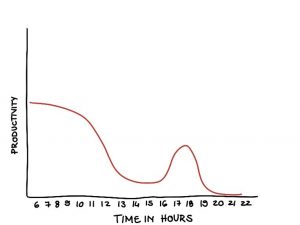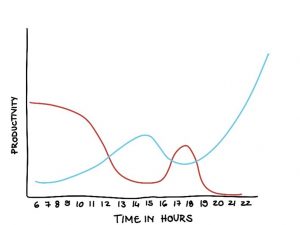I’m a morning person. I’m one of those people who leap out of bed at 05:00 am ready to take on the world. At work, I am at my best in the early hours – that’s when I can focus and get the best output. But, after lunch you can forget about getting anything valuable from me. I’m tired and flat. And then again, at about five o’clock there’s another burst of energy until dinner time. In bed by 21:00 (on a good day).
So, my productivity graph looks something like this:

In contrast, a colleagues’ productivity graph looks like this… He is not good in the morning but does his best work after 22:00. So, I try to schedule meetings with him just before lunch, or late afternoon when we are both fairly energetic.

The point is this: we all have times in the day where we are productive, and other times where we struggle to concentrate. Daniel Pink writes in his book “When” that most people have these peaks and troughs of energy throughout the day. The secret is that you have to figure out when yours are. If you have figured out what your graph looks like, you can schedule the work in your day based on what energy it needs. I have taken this advice to heart and schedule my day in such a way that I do thinking and designing work in the morning when I’m fresh, illustrations in the afternoon (I still enjoy the work but it’s not that cerebral) and research and reading early evening. I’ve stopped scheduling meetings for the mornings, rather moving them to the afternoons. I still have enough energy to have them, but don’t waste my productive morning hours.
| Morning | Design work, thinking, analytical, decisions |
| Afternoon | Illustrations, meetings (and a siesta!) |
| Early evening | Research, reading, social media |
And I have seen my productivity soar! Not only that but I hardly ever in a position where I have to drag myself reluctantly towards work.
So, here are a couple of tips:
- Keep a diary for a couple of days of how high/low your mental and physical energy is so that you can build up a typical graph;
- Identify which type of work needs which type of energy (physical and mental) and build up a picture of which time will be relevant for which type of work.
- Schedule the type of work (where possible) for where you can make best use of your energy.











